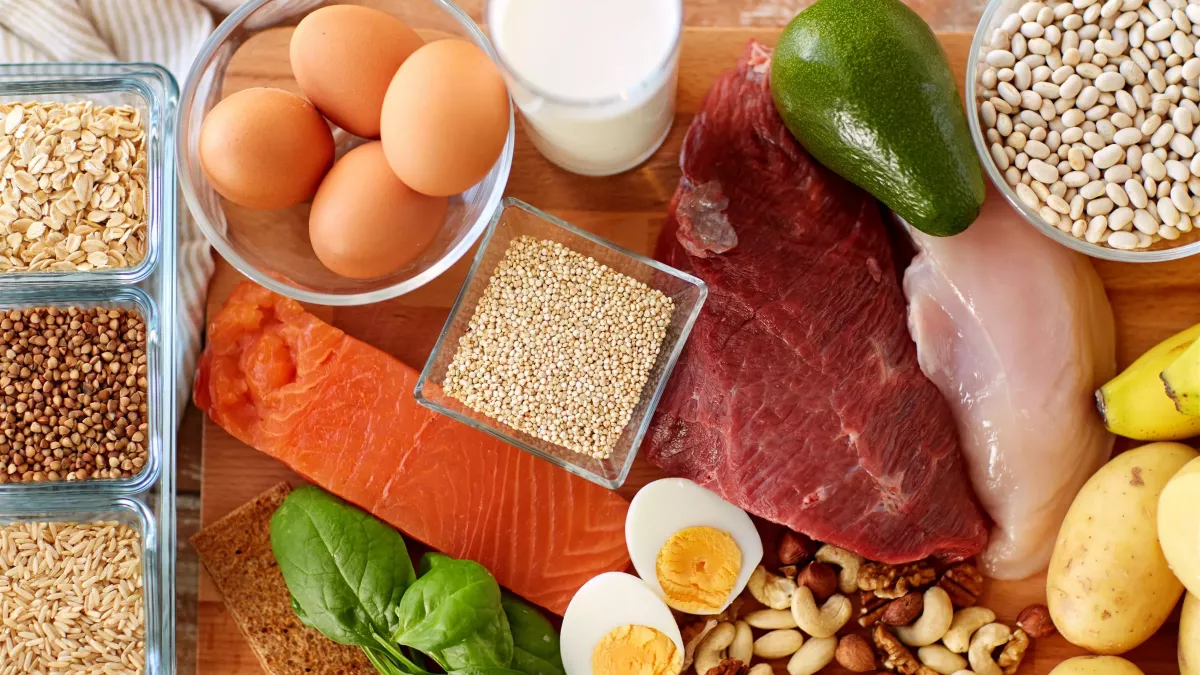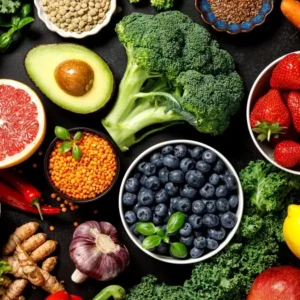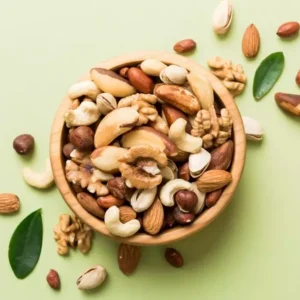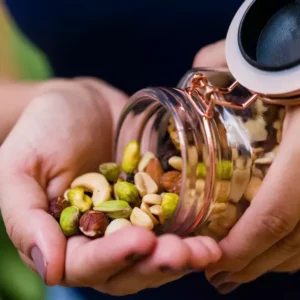Verified on 02/22/2022 by PasseportSanté
Protein is one of the macronutrients and plays several essential roles. For strong health and boost your energy, here is how to adapt your diet with proteins, according to your age. Decryption in this article.
What is protein?
Proteins are the main structural components of all cells in the human body.
Proteins are chains of amino acids which can be included in the composition:
- des muscles ;
- skin ;
- nails ;
- hairs ;
- you sang
Proteins are also the basis of many hormones, enzymes and antibodies and are necessary for the growth, repair and defense of tissues in the human body.
Protein characteristics
Proteins have many characteristics, they are:
- macronutrients essential for life;
- made up of amino acids, essential or not, which define the quality of the protein;
- in food, we find animal proteins and vegetable proteins;
- have many roles in the body (enzyme, transport, tissue structure, etc.);
Indeed, protein needs change over the course of our lives.
Why consume foods rich in protein?
Energy role
Protein provides energy, or 4 calories per gram. Like lipids and carbohydrates, proteins are essential macronutrients for the body.
C-reactive protein, a marker of inflammation
C-reactive protein (or CRP) is a protein synthesized by the liver during inflammation.
The CRP measurement is very common during a blood test, it allows you to see if the body is facing an attack.
Sources of essential amino acids
More than 20 natural amino acids are found in dietary proteins.
Nine are important amino acids that the body cannot make. They must therefore be obtained through food.
Other amino acids are nonessential because the body can produce them.
Structural role
Proteins participate in cell renewal, particularly in muscle tissue, skin and bone tissue.
Physiological processes
Proteins play many different roles in metabolism.
Some proteins are digestive enzymes allowing the assimilation of food molecules, others form antibodies and allow the body to defend itself against external attacks.
Finally, proteins are also part of the composition of hemoglobin and certain hormones.
20 foods rich in protein
The main sources of protein are animal products (meat, fish, eggs and dairy products).
Certain foods like legumes, nuts and seeds, and grain products are excellent sources of plant-based protein.
Finally, certain vegetables rich in protein also help meet the body’s needs.
|
Food |
Portions |
Quantity (g) |
|
Chicken breast, cooked, skinless |
100 g |
31 g |
|
Ground beef, lean, cooked |
100 g |
30 g |
|
Pork, chop, cooked |
100 g |
29 g |
|
Game meat, horse meat, cooked |
100 g |
28 g |
|
White fish (cod, sole, cod) |
100 g |
23-26 g |
|
Oily fish (salmon, trout, mackerel, etc.) |
100 g |
23-25 g |
|
Firm tofu |
100 g |
14 g |
|
Firm cheddar type cheese |
50 g |
11-12 g |
|
Soybeans |
30 g |
10 g |
|
Sliced Ham/Turkey Breast |
2 tranches (50 g) |
9 g |
|
Milk 0, 1, 2% mg |
1 cup (250ml) |
9 g |
|
Almonds |
35 g |
8 g |
|
Greek yogurt |
100 g |
8 g |
|
Enriched soy drink, all flavors |
1 cup (250ml) |
6-8 g |
|
large eggs |
1 (50 g) |
7 g |
|
Natural peanut/almond butter |
2 tbsp. soup |
5-7 g |
|
Silken tofu |
100 g |
6 g |
|
Pain complet |
1 tranche/30 g |
4-6 g |
|
Yogurt 0 to 2% mg |
100 g |
4 g |
|
Quinoa, cuit |
75 g |
3 g |
 Receive every day
Receive every day
advice from our experts
to take care of you

Use of proteins
Protein needs
| Population | ANC=Recommended Nutritional Intake (in g/kg/day) |
|---|---|
|
Babies 0-6 months |
1.52* |
|
Babies 7-12 months |
1.2 |
|
Babies 1-3 years old |
1.05 |
|
Children 4-8 years old |
0.95 |
|
Boys 9-13 years old |
0.95 |
|
Girls 9-13 years old |
0.95 |
|
Boys 14-18 years old |
0.85 |
|
Girls 14-18 years old |
0.85 |
|
Men 19-50 years old |
0.80 |
|
Women 19-50 years old |
0.80 |
|
Men aged 50 and over |
0.80 |
|
Women aged 50 and over |
0.80 |
|
Pregnant women |
1.1 |
|
Breastfeeding women |
1.3 |
*Insufficient data to calculate an ANC, therefore sufficient intake (AS) was determined.
There is not enough scientific data to support a higher ANC in physically active people.
On the other hand, since the type of exercise, its intensity, its duration and its frequency affect the use of proteins by the body, a protein intake higher than the ANC is often recommended for very active athletes (intense training every day ).
Here are the recommended quantities:
- Endurance athletes: 1.2 to 1.4 g/kg/day;
- Strength athletes: 1.2 to 1.7 g/kg/day;
Healthy adults can safely consume up to 25% of their total calories from protein.
In France, people consume on average around 17% of their calories in the form of protein.
Protein complementarity
Animal proteins (meats, dairy products, eggs) are complete proteins, meaning they contain all the amino acids essential for growth and maintaining the integrity of the body.
Plant proteins, on the other hand, do not contain all the amino acids in sufficient quantities to make them complete proteins. However, soy is an exception to this rule and contains all the essential amino acids.
To supplement plant proteins, there are several options:
- Combine a plant protein with an animal protein (for example, chili con carne);
- combine legumes (beans, lentils, chickpeas) with grain products (for example, a couscous and chickpea salad);
- combine legumes and oilseeds (for example, a lentil and almond salad).
It has long been believed that these associations had to be made within the same meal to ensure complementarity.
Recently, it has been shown that if complementary foods are consumed within a 24-hour period, the benefits of complete proteins are present.
However, pregnant women must make these food combinations within the same meal.
Protein diet
There are many protein diets and their indications are multiple.
Increasing protein intake may be particularly recommended to combat malnutrition or malabsorption phenomena.
Likewise, for athletes, it may be recommended to consume proteins around weight training sessions to promote the development of muscle mass.
This supplementation can be done naturally through food or using protein powders and other specialized supplements.
There are also protein diets intended for weight loss. However, they have never yet proven their validity in the long term.
Whatever your situation and before increasing your protein intake, it is recommended to consult a nutrition professional. Indeed, this is not without consequences.
Adverse effects of proteins
Consequences of a protein deficiency
An adequate amount of protein each day must be present in order to prevent protein-energy malnutrition.
Protein deficiency is very rare in industrialized countries, but can occur in hospitals in people with illnesses as well as in the elderly.
On the other hand, in developing countries, marasmus like kwashiorkor, two forms of protein-energy malnutrition are very present and cause the death of around 6 million children each year.
Protein deficiency has negative impacts on all organs and systems of the body such as the brain, cerebral functions, immune system and kidney function.
Signs of protein deficiency include edema (fluid retention or swelling), reduced muscle mass, dull skin, and thin, brittle hair.
Excess protein
The risk of having excessive protein intake from food is slim.
However, certain scientific studies carried out with high protein diets have demonstrated an increase in gastrointestinal disorders or a higher risk of osteoporosis or kidney stones.
On the other hand, the most recent data suggest that protein intake is not linked to the loss of calcium from bones or to other negative effects on bone health.
Some high-protein diets are often very rich in animal proteins and therefore also rich in saturated fats. It is therefore not surprising to see in the literature the correlation between the consumption of red meat and high-fat dairy products and cardiovascular diseases as well as certain types of cancer.
People with chronic kidney disease and certain genetic disorders need to continually evaluate their protein intake and should work with a dietitian to achieve this.
Interactions of proteins with other nutrients
The interactions between proteins and other nutrients are extremely numerous.
For example, they ensure the transport of the smallest nutrients in and out of the body’s cells. In this sense, we can affirm that an optimal nutritional state is essential for the proper functioning of the entire organism.
Chemical properties of proteins
Proteins are macronutrients at the basis of all living organisms. Amino acids linked together by peptide bonds form polypeptide chains. These polypeptide chains arranged together form, in turn, proteins.
Protein chains are synthesized inside the cell itself, in ribosomes. The order in which the amino acids are linked, called sequence, will determine their structure and function. All amino acids (except proline) consist of a carboxylic acid, a primary amine, and a side chain.
There are 22 protein-forming amino acids, including 9 so-called essential amino acids that the body cannot synthesize.
Protein electrophoresis is a method of protein analysis mainly used in medicine for the study of blood plasma. It makes it possible to analyze, from a simple blood test, the level of different proteins contained in the body.
Thus, it is possible to measure albumin, the level of which indicates malnutrition or certain liver or kidney pathologies.
Protein History
Proteins were discovered in 1835 in the Netherlands by chemist GJ Mulder.
The name protein comes from the Greek word “protos” which means first, in the essential sense.
Since then and over the centuries, the multiple roles of proteins in the human body have continued to be highlighted by scientists.
94% Readers found this article helpful And you ?
Was this article useful to you?












